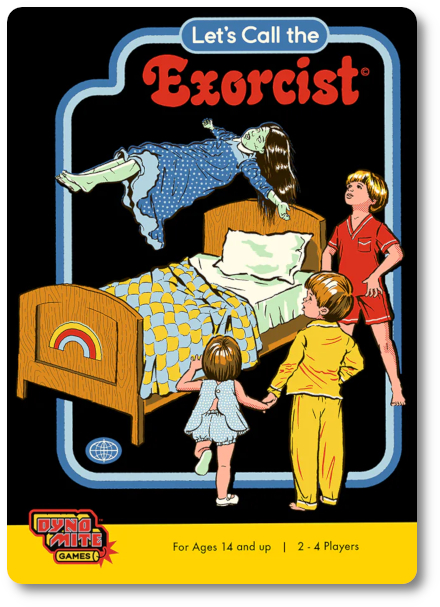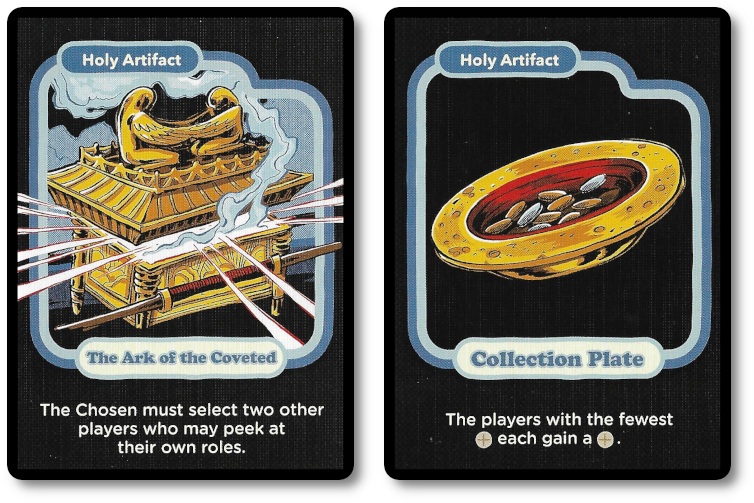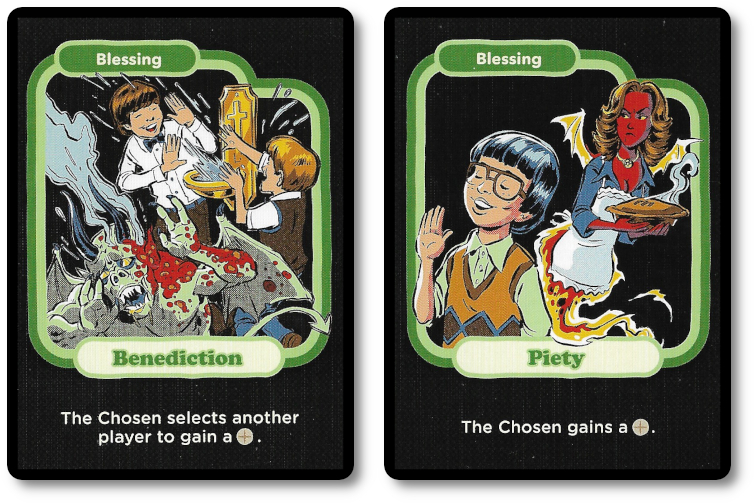 The Basics:
The Basics:
- For ages 10 and up (publisher suggests 14+)
- For 2 to 4 players
- Approximately 30 minutes to complete
Geek Skills:
- Active Listening & Communication
- Counting & Math
- Logical & Critical Decision Making
- Reading
- Memorization
- Cooperative & Team Play
- Bluffing and Misdirection
Learning Curve:
- Child – Easy
- Adult – Easy
Theme & Narrative:
- Have some fun while Mom and Dad are away with ancient relics best left alone
Endorsements:
- Gamer Geek mixed!
- Parent Geek mixed!
- Child Geek mixed!
Overview
American musician, best known as the co-founder, bassist, and primary songwriter of the heavy metal band Mötley Crüe, Nikki Sixx said, “If you don’t deal with your demons, they will deal with you, and it’s gonna hurt.” In this game, you will be possessed by mischievous demons or one of the many innocents who bump into trouble. However, in this game of hidden identities and switching roles, your effort to clear the way for the “good guys” could be an effort for the wrong party.
Let’s Call the Exorcist, designed by Cory Jones, Ben Stoll, Mataio Wilson and published by Cryptozoic Entertainment, is comprised of eight Role tiles, 43 cards, and 45 Point tokens. The game component quality is excellent, with thick cardboard and durable cards. Illustrations by Robb Mommaerts are colorful and fun, adding humor to an otherwise darkly themed game of supernatural possession.
Of important note are the illustrations on the cards, which are based on the excellent work of the very talented Steven Rhodes. He is well known for mixing nostalgic images of a simpler time with a touch of a dark twist to make you smile and then slightly furrow your brow out of concern. Look into Mr. Rhodes’ excellent work, and support this excellent artist!
Oh! Look! A Demonic Item! Let’s Play With It!
To set up the game, complete the following steps:
First, give each player one Point token. Any not given to a player should be placed in a small pile off to one side of the game-playing area and within easy reach of at least one player.
Second, separate the cards into “Cursed Artifacts,” “Holy Artifacts,” “Mischiefs,” and “Blessings.” Shuffle each deck separately. Using the guide in the rule book, randomly draw several “Holy Artifact” and “Cursed Artifact” cards based on the number of players. You’ll do the same for “Mischeifs” and “Blessings.” Once completed, all the cards selected will be shuffled together to create the draw deck for the game’s duration. Any unused cards should be returned to the game box and not looked at.
Third, and again using the rule book, prepare the Role tiles based on the number of players. Shuffle and deal one to each player, face-down. Players should look at their Role tile but keep them hidden from their opponents. Unlike other games, players cannot look at their Role tile again once they take a peek, so make sure you take a long and hard stare to help you remember.
That’s it for the game setup. Determine who will be the first player, giving them the title of “Seeker.”
Fun with Demons
Let’s Call the Exorcist is played in rounds and turns with no set number of rounds or turns per game. A round of gameplay is summarized here.
Step One: The Starting Deal
The first deal of the game begins with a player dealing out all the cards in the draw deck, face-down, to each player. Each player will have the same number of cards. Once players have their cards, they should pick them up and look at them. The possible cards are as follows:
Cursed Artifacts
These are needed for the “Possessed” players to win the game.

Holy Artifacts
These are needed for the “Innocent” players to win the game.

Mischiefs
These cards change the turn order and how players interact.

Blessings
These beneficial cards will reward the players with helpful points or options.

After looking at their cards, the players should take turns describing the cards they have in their hands in general terms. Something like, “Boy, I sure do have a lot of holy artifacts!” would be acceptable. The idea here is that players are communicating to the others at the table where they stand concerning how they want their cards to play out based on their role.
- Innocent Players win the round if all the “Holy Artifacts” are revealed.
- Possessed Players win the round if all the “Cursed Artifacts” are revealed.
After everyone has a turn describing their cards, they shuffle them and place them face-down in front of them. Interestingly, all players will have a good idea of what cards they have in their possession but will not know what cards are in play. There’s a reason for this, as you will soon discover.
Step Two: Take Turns
All players now pick one card at random that they place face-down. These cards are placed in the middle of the playing area and remain face-down at all times.
The player, currently the “Seeker,” now selects one of the face-down cards. Any card may be selected other than their own. This is referred to as the “Reveal.” The revealed card is placed face-up and made visible to all the players. The revealed card is then immediately resolved.
The player with their card selected is called the “Chosen” and becomes the new “Seeker.” The new “Seeker” asks all the other players to select a card and picks one, again revealing it and resolving the card.
This continues until the deal is completed.
Step Three: Ending the Deal
The deal ends once there are as many face-up cards as are equal to the number of players in the game.
All the face-up cards are now moved to the center of the playing area to allow all players to view which cards were revealed during the deal.
The last player who was “Chosen” now collects all the face-down cards, shuffles them, and deals them out, so each player has the same number of cards. They also become the “Seeker.” Repeat the new round starting with step one noted above.
Blessing and Curses
The round ends when either the last “Holy Artifact” or the last “Cursed Artifact” is revealed and resolved.
All players now reveal their Role tile. The first group (“Innocent” or “Possessed”) to reveal all their needed artifacts first now scores a point. Hand out two Point tokens to each of the scoring players.
If none of the players have seven or more points, it’s time for a new round of gameplay! Take all the cards and shuffle them. Take back the Role tiles, shuffle those, and reassign them to a new player. Keep doing this until the game comes to an end.
Salvation
The game ends when a player has seven or more points at the end of the round. The player with the most points wins the game!
To learn more about Let’s Call the Exorcist, visit the game’s webpage.
Final Word
 The Child Geeks enjoyed the game, trying to figure out who was who and on what team they were working. However, they didn’t particularly care for switching teams, which is part of the game’s core mechanics. According to one Child Geek, “I like the game, and I think the artwork is really funny. I liked playing it but didn’t like it when I was on the winning side and suddenly on the losing side.” Another Child Geek said, “I thought it was fun and would play it again. The game feels funny as it keeps changing things, making me think I shouldn’t take it seriously and have fun with my family.” In the end, the Child Geeks enjoyed the game but did not agree regarding what level that “fun” was provided. Some Child Geeks found the game a great time, and some found it too frustrating to play again. The majority found the game a perfect mix of chaos and charm, resulting in a mixed review from our youngest players.
The Child Geeks enjoyed the game, trying to figure out who was who and on what team they were working. However, they didn’t particularly care for switching teams, which is part of the game’s core mechanics. According to one Child Geek, “I like the game, and I think the artwork is really funny. I liked playing it but didn’t like it when I was on the winning side and suddenly on the losing side.” Another Child Geek said, “I thought it was fun and would play it again. The game feels funny as it keeps changing things, making me think I shouldn’t take it seriously and have fun with my family.” In the end, the Child Geeks enjoyed the game but did not agree regarding what level that “fun” was provided. Some Child Geeks found the game a great time, and some found it too frustrating to play again. The majority found the game a perfect mix of chaos and charm, resulting in a mixed review from our youngest players.
 The Parent Geeks were very similar in their reaction to the game. They found the illustrations comical, the shifting roles and actions in the game engaging, but the overall ability to win the game to be a random offering of opportunity rather than a strategic and tactical concrete path they could travel. According to one Parent Geek, “I had fun with it and found a lot of the game to be very humorous. What I did not care for was how difficult – or better put – how little one should care about winning. I play games to be competitive. This game does provide competition, but the rules are constantly shifting. It reminded me a bit of Fluxx, to be honest, which I think is fine, but players should be aware that the ground in this game is anything but solid.” Another Parent Geek said, “Good stuff. Random and crazy. This is not a game you take seriously unless you want serious fun with family and friends playing a game over the top. I enjoyed it.” The Parent Geeks found Let’s Call the Exorcists a mixed bag when the last demon was exercised.
The Parent Geeks were very similar in their reaction to the game. They found the illustrations comical, the shifting roles and actions in the game engaging, but the overall ability to win the game to be a random offering of opportunity rather than a strategic and tactical concrete path they could travel. According to one Parent Geek, “I had fun with it and found a lot of the game to be very humorous. What I did not care for was how difficult – or better put – how little one should care about winning. I play games to be competitive. This game does provide competition, but the rules are constantly shifting. It reminded me a bit of Fluxx, to be honest, which I think is fine, but players should be aware that the ground in this game is anything but solid.” Another Parent Geek said, “Good stuff. Random and crazy. This is not a game you take seriously unless you want serious fun with family and friends playing a game over the top. I enjoyed it.” The Parent Geeks found Let’s Call the Exorcists a mixed bag when the last demon was exercised.
 The Gamer Geeks were not far off from their Child and Parent Geek counterparts, finding merit in the game but also some troublesome woes and frustration. As one Gamer Geek put it, “A game you need to understand that is based on shifting priorities. If you get that, you’ll have fun. If you hate that, you’ll hate the game. A pretty easy approach to enjoy the game or not.” Another Gamer Geek said, “A lighthearted game of shifting roles and victory conditions. Lots of games like this around, and I found this one to share many charatericists but with a fun new theme. I’d play it again around Halloween.” When the last blessing was counted, and the relics put safely away, the Gamer Geeks found Let’s Call the Exorcist worth their time, but not always of great value.
The Gamer Geeks were not far off from their Child and Parent Geek counterparts, finding merit in the game but also some troublesome woes and frustration. As one Gamer Geek put it, “A game you need to understand that is based on shifting priorities. If you get that, you’ll have fun. If you hate that, you’ll hate the game. A pretty easy approach to enjoy the game or not.” Another Gamer Geek said, “A lighthearted game of shifting roles and victory conditions. Lots of games like this around, and I found this one to share many charatericists but with a fun new theme. I’d play it again around Halloween.” When the last blessing was counted, and the relics put safely away, the Gamer Geeks found Let’s Call the Exorcist worth their time, but not always of great value.
 Let’s Call the Exorcist plays off the well-defined hidden roles genre of games we have come to know and love. This is not by any means new territory, nor should it be considered a corner of the gaming world that is over-explored. There is still much ground to venture here ever since Are You a Werewolf was first released, and games like it continue to frustrate and entertain countless gamers at conventions and geeky gatherings. The absurd theme and narrative make this game stand apart, further reinforced by how you keep track of points. The Point tokens are designed to look like a Communion wafer, a sacramental bread held in great respect by Christian faiths. That said, anyone particularly sensitive to anything shooting a tongue or cheek at religion should avoid the game. Nothing offensive, mind you, but one can never account for personal sensitivity on such topics.
Let’s Call the Exorcist plays off the well-defined hidden roles genre of games we have come to know and love. This is not by any means new territory, nor should it be considered a corner of the gaming world that is over-explored. There is still much ground to venture here ever since Are You a Werewolf was first released, and games like it continue to frustrate and entertain countless gamers at conventions and geeky gatherings. The absurd theme and narrative make this game stand apart, further reinforced by how you keep track of points. The Point tokens are designed to look like a Communion wafer, a sacramental bread held in great respect by Christian faiths. That said, anyone particularly sensitive to anything shooting a tongue or cheek at religion should avoid the game. Nothing offensive, mind you, but one can never account for personal sensitivity on such topics.
Given that, the game was found to be enjoyable by most, with a mixed review of what “enjoyable” really means in the context of the game. It’s short, fast, and frustrating. You’ll win and lose, and in the end, most of the players didn’t seem to think that either endgame result mattered too much. It wasn’t that they found the game to be worthless or not worth their time. Just the opposite. Instead, it was more of a question of “what did I just play, and did I enjoy it?” This is an interesting question to hear players ask after they have played the game several times and still haven’t come up with an answer.
As for me, I liked it. I found the game fast, fun, engaging, and slightly vulgar. Having grown up on horror movies – specifically The Exorcist – I was laughing most of the time. This is not a game you will necessarily truly love or overly hate. It’s a game you’ll play and enjoy at the moment and depending on those you played the game with, you want to play it again or forget about it entirely. It’s a strange game, indeed.
Should you try it? Of course. Like any hidden role game, you’ll find its approach to be on the spot or well off track. Either way, you lose nothing from trying this game to see if it’s a blessing or a curse at your family gaming table.
This game was given to Father Geek as a review copy. Father Geek was not paid, bribed, wined, dined, or threatened in vain hopes of influencing this review. Such is the statuesque and legendary integrity of Father Geek.



